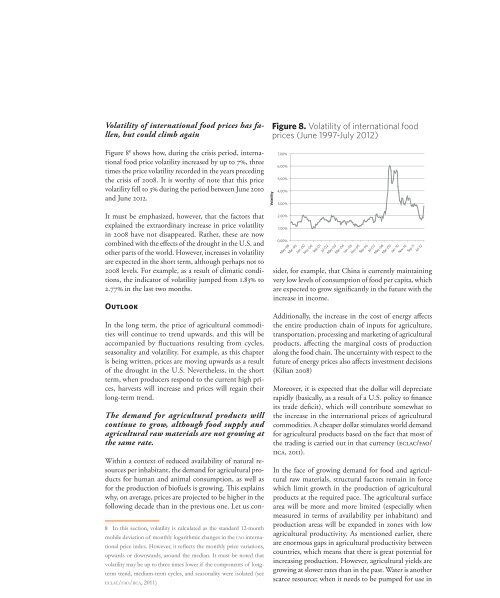1eVf8UD
1eVf8UD
1eVf8UD
Create successful ePaper yourself
Turn your PDF publications into a flip-book with our unique Google optimized e-Paper software.
Volatility of international food prices has fallen,<br />
but could climb again<br />
Figure 8. Volatility of international food<br />
prices (June 1997-July 2012)<br />
Figure 8 8 shows how, during the crisis period, international<br />
food price volatility increased by up to 7%, three<br />
times the price volatility recorded in the years preceding<br />
the crisis of 2008. It is worthy of note that this price<br />
volatility fell to 3% during the period between June 2010<br />
and June 2012.<br />
It must be emphasized, however, that the factors that<br />
explained the extraordinary increase in price volatility<br />
in 2008 have not disappeared. Rather, these are now<br />
combined with the effects of the drought in the U.S. and<br />
other parts of the world. However, increases in volatility<br />
are expected in the short term, although perhaps not to<br />
2008 levels. For example, as a result of climatic conditions,<br />
the indicator of volatility jumped from 1.83% to<br />
2.77% in the last two months.<br />
Outlook<br />
In the long term, the price of agricultural commodities<br />
will continue to trend upwards, and this will be<br />
accompanied by fluctuations resulting from cycles,<br />
seasonality and volatility. For example, as this chapter<br />
is being written, prices are moving upwards as a result<br />
of the drought in the U.S. Nevertheless, in the short<br />
term, when producers respond to the current high prices,<br />
harvests will increase and prices will regain their<br />
long-term trend.<br />
The demand for agricultural products will<br />
continue to grow, although food supply and<br />
agricultural raw materials are not growing at<br />
the same rate.<br />
Within a context of reduced availability of natural resources<br />
per inhabitant, the demand for agricultural products<br />
for human and animal consumption, as well as<br />
for the production of biofuels is growing. This explains<br />
why, on average, prices are projected to be higher in the<br />
following decade than in the previous one. Let us con-<br />
8 In this section, volatility is calculated as the standard 12-month<br />
mobile deviation of monthly logarithmic changes in the FAO international<br />
price index. However, it reflects the monthly price variations,<br />
upwards or downwards, around the median. It must be noted that<br />
volatility may be up to three times lower if the components of longterm<br />
trend, medium-term cycles, and seasonality were isolated (see<br />
ECLAC/FAO/IICA, 2011)<br />
sider, for example, that China is currently maintaining<br />
very low levels of consumption of food per capita, which<br />
are expected to grow significantly in the future with the<br />
increase in income.<br />
Additionally, the increase in the cost of energy affects<br />
the entire production chain of inputs for agriculture,<br />
transportation, processing and marketing of agricultural<br />
products, affecting the marginal costs of production<br />
along the food chain. The uncertainty with respect to the<br />
future of energy prices also affects investment decisions<br />
(Kilian 2008)<br />
Moreover, it is expected that the dollar will depreciate<br />
rapidly (basically, as a result of a U.S. policy to finance<br />
its trade deficit), which will contribute somewhat to<br />
the increase in the international prices of agricultural<br />
commodities. A cheaper dollar stimulates world demand<br />
for agricultural products based on the fact that most of<br />
the trading is carried out in that currency (eclac/fao/<br />
iica, 2011).<br />
In the face of growing demand for food and agricultural<br />
raw materials, structural factors remain in force<br />
which limit growth in the production of agricultural<br />
products at the required pace. The agricultural surface<br />
area will be more and more limited (especially when<br />
measured in terms of availability per inhabitant) and<br />
production areas will be expanded in zones with low<br />
agricultural productivity. As mentioned earlier, there<br />
are enormous gaps in agricultural productivity between<br />
countries, which means that there is great potential for<br />
increasing production. However, agricultural yields are<br />
growing at slower rates than in the past. Water is another<br />
scarce resource; when it needs to be pumped for use in<br />
36 The Outlook for Agriculture and Rural Development in the Americas –eclac fao iica–<br />
Volatility<br />
7,00%<br />
6,00%<br />
5,00%<br />
4,00%<br />
3,00%<br />
2,00%<br />
1,00%<br />
0,00%<br />
May-98<br />
Mar-99<br />
Jan -00<br />
Nov-00<br />
Sep-01<br />
Jul-02<br />
May-03<br />
Mar-04<br />
Jan -05<br />
Nov-05<br />
Sep-06<br />
Jul-07<br />
May-08<br />
Mar-09<br />
Jan -10<br />
Nov-10<br />
Sep-11<br />
Jul-12


